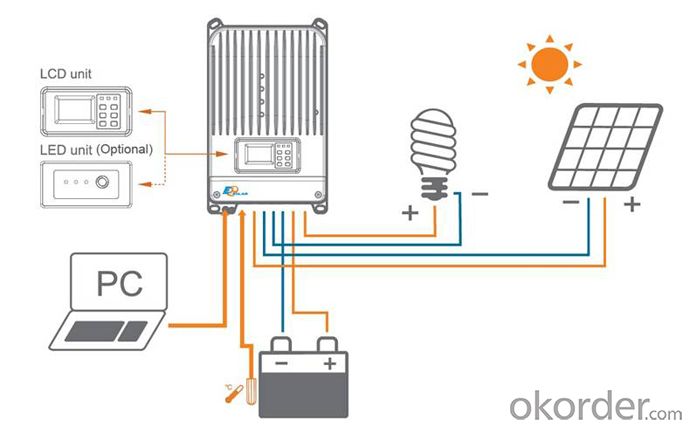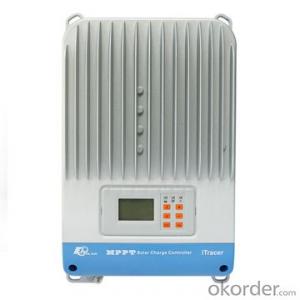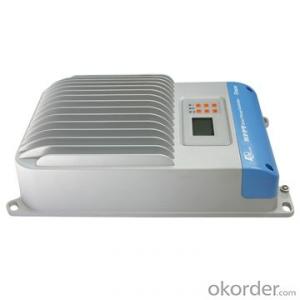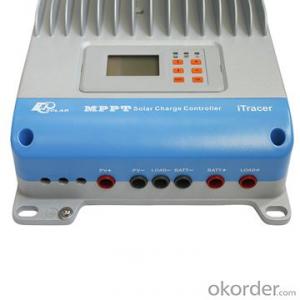iTracer Series MPPT Solar Charge Controller/Solar Battery Charge Regulator for Solar Power System
- Loading Port:
- Tianjin
- Payment Terms:
- TT or LC
- Min Order Qty:
- 30 watt
- Supply Capability:
- 10000 watt/month
OKorder Service Pledge
OKorder Financial Service
You Might Also Like
iTracer is an industrial grade product with advanced Maximum Power Point Tracking (MPPT) algorithm. It can deliver the maximum available power for charging batteries and charge a lower nominal voltage battery from a higher nominal voltage array.
Features:
• Advanced MPPT algorithm with the max. tracking efficiency of 99%
• Multi-phase synchronous rectification technology realizing peak conversion efficiency 98%
• Dual-core(ARM CPU+DSP) control architecture improves the system response speed and optimizes the performance of the system
• Multiphase control technology, optimizes charging current smoothness, reduces ripple and improves the system efficiency
• 128*64 dot-matrix LCD intuitively displays data and state, 6 buttons combinations for easy operation
• Four battery type options: Sealed, Gel, Flooded and User-defined
• Energy statistics recording, it is convenient for users to view charging and discharging energy of each day, month, year and total value.
• Diversified load control mode
• Programmable battery management parameters
• Built-in running data and event logging, max. 15 months
• Extensive communication capabilities (RS232,RS485 with Modbus protocol, CAN Bus extendable)
• PC software available for real time monitoring and parameter setting
• Field upgradable firmware
Electronic Protections:
• PV short circuit protection
• PV overvoltage protection
• PV over current protection
• PV reverse polarity protection
• Reverse current protection at night
• Over temperature protection
• Battery reverse polarity protection
• Load overload protection
• Load short circuit protection

Specification:
Model | IT3415ND | IT4415ND | IT6415ND |
Rated system voltage | 12V/24V /36V/48V auto work | ||
Rated battery current | 30A | 45A | 60A |
Rated load current | 30A | 45A | 60A |
Max. PV open circuit voltage | 150V | ||
Voltage range | 8~72V | ||
Max.PV input power | 400W (12V) | 600W (12V) | 800W (12V) |
800W (24V) | 1200W (24V) | 1600W (24V) | |
1200W (36V) | 1800W (36V) | 2400W (36V) | |
1600W (48V) | 2400W (48V) | 3200W (48V) | |
Self-consumption | 1.4~2.2W | ||
Equalize charging voltage | Sealed: 14.6V, Flooded: 14.8V, User-defined: 9~17V | ||
Boost charging voltage | Gel: 14.2V, Sealed: 14.4V, Flooded: 14.6V, User-defined: 9~17V | ||
Float charging voltage | Gel /Sealed /Flooded: 13.8V, User-defined: 9~17V | ||
Low voltage reconnect voltage | Gel /Sealed /Flooded: 12.6V, User-defined: 9~17V | ||
Low voltage disconnect voltage | Gel /Sealed /Flooded: 11.1V, User-defined: 9~17V | ||
Grounding | Common negative | ||
Tracking efficiency | 99% | ||
Peak conversion efficiency | 98% | ||
Dimension | 358x219x102mm | 382x231x107mm | 440x231x110mm |
Terminal | 25mm2 | 35mm2 | 35mm2 |
Net Weight | 3.7kg | 4.6kg | 5.9kg |
Working temperature | -25℃~+55℃ | ||
Storage temperature range | -30℃~+85℃ | ||
Humidity | 95% NC | ||
Enclosure | IP20 | ||
FAQ:
Q1. What is the voltage?
A1. Our 45/60A solar charge controller is 12/24/36/48V auto work.
Q2. What is the difference between MPPT&PWM?
A2. MPPT has higher efficiency, it can track the max power point and won't waste energy.
Q3. What is the efficiency of the MPPT controller?
A3. MPPT>99%, peak conversion efficiency>98%.
Q4. What is the waranty of product?
A4. 12 months.
Q5. What protection does your MPPT controller have?
A5. PV array short circuit, PV reverse polarity, Battery reverse polarity, Over charging, Output short circuit.
- Q:Can a solar controller be used with solar panels of different mounting systems?
- Yes, a solar controller can be used with solar panels of different mounting systems. The solar controller's primary function is to regulate the charging and discharging of energy between the solar panels and the battery bank. It does not depend on the mounting system of the panels, but rather on the voltage and current output of the solar panels. As long as the solar panels are compatible with the solar controller's specifications, they can be used together regardless of the mounting system.
- Q:Can a solar controller be used with solar-powered water heaters?
- Yes, a solar controller can be used with solar-powered water heaters. A solar controller helps regulate the flow of energy from the solar panels to the water heater, ensuring optimal performance and efficiency. It helps monitor and control the temperature and pressure of the system, preventing overheating or damage. Overall, a solar controller is an essential component in maximizing the effectiveness of solar-powered water heaters.
- Q:Can a solar controller be used with solar panels of different angles?
- Yes, a solar controller can be used with solar panels of different angles. The purpose of a solar controller is to regulate the flow of electricity from the solar panels to the battery or grid. It does not depend on the angle of the solar panels. The angle of the solar panels affects the efficiency and output of the solar system, but it does not impact the compatibility or functionality of the solar controller. Therefore, regardless of the angle of the solar panels, a solar controller can still be used to manage the charging and discharging of the battery or the flow of electricity to the grid.
- Q:How does a solar controller handle battery overvoltage disconnect recovery?
- The battery overvoltage disconnect recovery is managed by a solar controller, which utilizes specific functions and features. When the battery voltage surpasses a particular threshold, the overvoltage disconnect feature of the controller is activated. This feature separates the charging source (solar panel) from the battery to prevent further charging. Once the overvoltage disconnect is triggered, the solar controller enters a recovery mode. Throughout this period, the controller continuously monitors the battery voltage to guarantee that it decreases below a safe level before reconnecting the charging source. This is crucial for safeguarding the battery against potential damage caused by excessive voltage. The recovery process typically includes gradually reconnecting the charging source to the battery. The controller may employ a mechanism that delays reconnection, allowing the battery voltage to stabilize and decrease to a safe level before resuming the charging process. This helps prevent any sudden increases in voltage that could harm the battery. Furthermore, some solar controllers may incorporate a soft-start feature during the recovery phase. This means that instead of immediately supplying the battery with the full charging current, the controller begins with a lower current and gradually increases it until it reaches the desired charging rate. This gentle approach prevents any sudden shocks to the battery resulting from a sudden surge in charging current. In conclusion, the battery overvoltage disconnect recovery mechanism of a solar controller ensures the safe and efficient charging of the battery by carefully monitoring its voltage and implementing gradual reconnection strategies to prevent any further instances of overvoltage.
- Q:Can a solar controller be used with a battery bank that has different battery chemistries?
- No, a solar controller cannot be used with a battery bank that has different battery chemistries. It is essential to use batteries with the same chemistry in a battery bank to ensure proper charging and discharging cycles. Mixing different battery chemistries can lead to imbalances, inefficient charging, and potential damage to the batteries.
- Q:Can a solar controller be used with solar-powered indoor recreational facilities?
- Solar-powered indoor recreational facilities can make use of a solar controller. This component is essential in a solar power system as it regulates the flow of electricity from the solar panels to the batteries. Its main function is to ensure efficient charging of the batteries and prevent any potential damage caused by overcharging. When it comes to solar-powered indoor recreational facilities like indoor swimming pools, gyms, or entertainment centers, the solar controller plays a crucial role in managing the energy generated by the solar panels. It helps optimize energy usage, store excess energy in batteries, and guarantee a continuous power supply even in low or no sunlight conditions. By incorporating a solar controller, these indoor recreational facilities can significantly reduce their reliance on traditional grid electricity, resulting in lower energy costs and a promotion of sustainability. Additionally, it enables them to operate independently from the grid, enhancing their ability to withstand power outages or other disruptions. All in all, including a solar controller in a solar-powered indoor recreational facility is a wise and environmentally friendly choice that can lead to long-term savings and various environmental benefits.
- Q:Can a solar controller be used with a solar-powered water heater for swimming pools?
- Yes, a solar controller can be used with a solar-powered water heater for swimming pools. A solar controller helps regulate and control the flow of heated water from the solar panels to the pool, ensuring optimal energy efficiency and temperature control.
- Q:How does a solar controller handle battery over-temperature disconnect recovery?
- A solar controller is designed to regulate the charging and discharging of batteries in a solar power system. When it comes to battery over-temperature disconnect recovery, the solar controller plays a crucial role in protecting the batteries from potential damage. In the event of battery over-temperature, the solar controller detects the excessive heat and initiates a safety mechanism to disconnect the battery from the charging source. This is done to prevent further heating and potential damage to the battery. Once the battery has been disconnected, the solar controller continuously monitors the temperature of the battery. It waits for the temperature to drop to a safe level before initiating the recovery process. The recovery process involves reconnecting the battery to the charging source and resuming the charging process. During the recovery process, the solar controller closely monitors the temperature of the battery to ensure it remains within a safe range. If the temperature starts to rise again, the controller will immediately disconnect the battery once more to prevent any further damage. Additionally, some advanced solar controllers may have built-in safety features such as temperature sensors or thermal protection circuits. These features provide an extra layer of protection by actively monitoring the battery temperature and taking appropriate actions to prevent over-temperature conditions. Overall, a solar controller handles battery over-temperature disconnect recovery by detecting the excessive heat, disconnecting the battery from the charging source, monitoring the temperature, and initiating the recovery process once the temperature drops to a safe level. It ensures that the batteries are protected from overheating and potential damage, thereby maximizing their lifespan and performance in a solar power system.
- Q:Can a solar controller be used with solar-powered charging stations?
- Yes, a solar controller can be used with solar-powered charging stations. A solar controller helps regulate and optimize the charging process by managing the flow of electricity from the solar panels to the charging stations. It ensures that the batteries are charged efficiently and protects them from overcharging or damage. Therefore, integrating a solar controller is essential for the proper functioning and longevity of solar-powered charging stations.
- Q:Can a solar controller be used with solar-powered electric vehicles?
- Yes, a solar controller can be used with solar-powered electric vehicles. A solar controller regulates and controls the charge from solar panels to the batteries of the vehicle, ensuring efficient charging and preventing overcharging. This helps in maximizing the usage of solar energy and extending the battery life of the electric vehicle.
1. Manufacturer Overview |
|
|---|---|
| Location | |
| Year Established | |
| Annual Output Value | |
| Main Markets | |
| Company Certifications | |
2. Manufacturer Certificates |
|
|---|---|
| a) Certification Name | |
| Range | |
| Reference | |
| Validity Period | |
3. Manufacturer Capability |
|
|---|---|
| a)Trade Capacity | |
| Nearest Port | |
| Export Percentage | |
| No.of Employees in Trade Department | |
| Language Spoken: | |
| b)Factory Information | |
| Factory Size: | |
| No. of Production Lines | |
| Contract Manufacturing | |
| Product Price Range | |
Send your message to us
iTracer Series MPPT Solar Charge Controller/Solar Battery Charge Regulator for Solar Power System
- Loading Port:
- Tianjin
- Payment Terms:
- TT or LC
- Min Order Qty:
- 30 watt
- Supply Capability:
- 10000 watt/month
OKorder Service Pledge
OKorder Financial Service
Similar products
New products
Hot products
Related keywords































